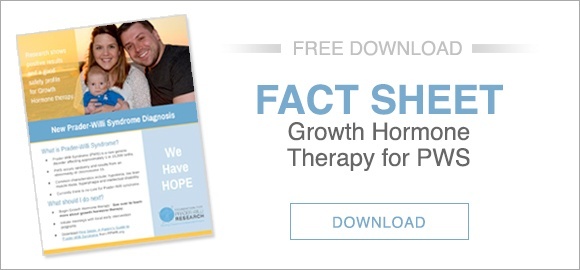This article is adapted from a presentation by Jennifer Miller, Ph.D.
 Human growth hormone therapy for PWS been proven to improve characteristic delays in physical and social development, and the cognitive benefits of human growth hormone for PWS are well documented too.
Human growth hormone therapy for PWS been proven to improve characteristic delays in physical and social development, and the cognitive benefits of human growth hormone for PWS are well documented too.
HGH dosing for PWS varies according to the age of the patient and to their individual characteristics. The common dosages for children and adults and considerations doctors use to determine dosage are outlined below.
HGH Dosing for Children With PWS
In children with PWS, it's recommended to start with 1 mg/m2 of body surface area per day. It's typical for infant dosages to be this high because of their fast metabolism. Often in the 2-year-old to 4-year-old age range, the child's metabolism starts to decrease, so it's also necessary to decrease the initial dose of growth hormone along with it.
Endocrinologists base their dose adjustments on different criteria: body weight, body surface area, or the patient's IGF-1 levels. Insulin-like growth factor 1, or IGF-1, is a hormone that plays an important role in childhood growth, and it also has anabolic effects in adults. Its production is directly linked to levels of the growth hormone present in the body, so it's often used as an indicator of whether the treatment dose being given is best.
Studies have shown that when children with growth hormone deficiencies—not specifically PWS patients—were dosed based on their IGF-1 levels, it resulted in the best growth velocity and the best height outcomes. The aim is for all children and adults to have IGF-1 levels in the upper 2/3 of their normal range.
HGH Dosing for Adults With PWS
In prescribing human growth hormone for adults with PWS, dosing typically starts from 0.2 to 0.4 mg/day. For women with PWS, it's often required to have a higher dose than men with PWS. Estrogen interferes with growth hormone metabolism, and because human growth hormone dosing for PWS is often accompanied by estrogen supplementation for their bone health and cardiovascular health, they will have higher prescribed doses than male patients.
Knowing When A Dose Is Right
When an infant with PWS is maintained at human growth hormone does that is too high, they may show signs of acromegaly, characterized by a bigger chin and head, and arachnodactyly, or long, skinny fingers. Eventually, it can cause children to grow bigger organs, such as the heart, which is not ideal.
The preferred time to administer growth hormone is during the nighttime, right before the patient goes to sleep. Growth hormone is produced and secreted while we sleep, so by doing so, the natural physiology of the hormone is mimicked.
Final Considerations
Endocrinologists who prescribe human growth hormone dosing for PWS are above all interested in the overall health of the patient. That's why they look at the whole picture, not just hormone levels or height, and adjust accordingly. Everyone should be aware that there's not a set dose for all patients; every patient is different.
The end goal is for the patient to obtain the maximum benefit from the treatment for a better, fuller life.
Click below to watch a video of Dr. Miller's presentation:
Learn more about the importance of growth hormone therapy for PWS.








